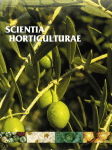Ver ítem
- xmlui.general.dspace_homeCentros Regionales y EEAsCentro Regional Mendoza - San JuanEEA JunínArtículos científicosxmlui.ArtifactBrowser.ItemViewer.trail
- Inicio
- Centros Regionales y EEAs
- Centro Regional Mendoza - San Juan
- EEA Junín
- Artículos científicos
- Ver ítem
Relationships between olive yield components and simulated irradiance within hedgerows of various row orientations and spacings
Resumen
An model of distribution of irradiance within hedgerows is shown to explain well the distribution of fruit size and oil concentration, and less so fruit density, within a range of super-high density (SHD) rectangular olive hedgerow structures of various combinations of row orientation and spacing. Results reveal that profiles of fruit size, oil concentration and fruit density of the orientation and spacing experiments are best explained by simulated mean
[ver mas...]
An model of distribution of irradiance within hedgerows is shown to explain well the distribution of fruit size and oil concentration, and less so fruit density, within a range of super-high density (SHD) rectangular olive hedgerow structures of various combinations of row orientation and spacing. Results reveal that profiles of fruit size, oil concentration and fruit density of the orientation and spacing experiments are best explained by simulated mean daily horizontal irradiance on the component foliage for the periods DOY (day of year) 150–180 and DOY 180–210, when fruit number is defined (i.e., flowering, fruit set and fruit drop). In all experiments, analyzed individually, relationships of fruit size and oil concentration were linear over the range of irradiance [8–50 mol photosynthetically active radiation (PAR)/m2] but fruit density was linear to a maximum density achieved around 27 mol PAR/m2 (40% of incident irradiance). When data from all experiments were normalized and pooled in single relationships, fruit size (R2 = 0.76; P < 0.001; n = 110) and oil concentration (R2 = 0.65; P < 0.001; n = 110) remained strongly linear while fruit density increased linearly (R2 = 0.31; P < 0.01; n = 80) to a maximum value at 28 mol/m2 (41% horizontally incident). The model was also used to estimate daily radiation interception by the hedgerows in order to calculate radiation-use efficiency (RUE) for oil production. The average annual RUE was 0.0269 ± 0.0018 g oil/mol PAR (0.1232 ± 0.0061 g/MJ PAR) with relatively little variation over the range of hedgerow orientation and spacing in which interception of incident irradiance varied 56–87%. The analyses reveal that the present model can assist design and analysis of performance of a wide range of olive hedgerow orchard structures and also the design and analysis of future experiments required to extend knowledge to a wider range of hedgerow structures and environments.
[Cerrar]

Autor
Connor, David J.;
Gómez del Campo, María;
Trentacoste, Eduardo Rafael;
Fuente
Scientia Horticulturae 198 : 12-20 (January 2016)
Fecha
2016-01-26
ISSN
0304-4238
Formato
pdf
Tipo de documento
artículo
Palabras Claves
Derechos de acceso
Restringido
 Excepto donde se diga explicitamente, este item se publica bajo la siguiente descripción: Creative Commons Attribution-NonCommercial-ShareAlike 2.5 Unported (CC BY-NC-SA 2.5)
Excepto donde se diga explicitamente, este item se publica bajo la siguiente descripción: Creative Commons Attribution-NonCommercial-ShareAlike 2.5 Unported (CC BY-NC-SA 2.5)

